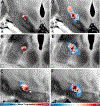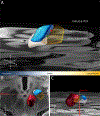Connectivity Profile for Subthalamic Nucleus Deep Brain Stimulation in Early Stage Parkinson Disease
- PMID: 37177857
- PMCID: PMC10846105
- DOI: 10.1002/ana.26674
Connectivity Profile for Subthalamic Nucleus Deep Brain Stimulation in Early Stage Parkinson Disease
Abstract
Objective: This study was undertaken to describe relationships between electrode localization and motor outcomes from the subthalamic nucleus (STN) deep brain stimulation (DBS) in early stage Parkinson disease (PD) pilot clinical trial.
Methods: To determine anatomical and network correlates associated with motor outcomes for subjects randomized to early DBS (n = 14), voxelwise sweet spot mapping and structural connectivity analyses were carried out using outcomes of motor progression (Unified Parkinson Disease Rating Scale Part III [UPDRS-III] 7-day OFF scores [∆baseline➔24 months, MedOFF/StimOFF]) and symptomatic motor improvement (UPDRS-III ON scores [%∆baseline➔24 months, MedON/StimON]).
Results: Sweet spot mapping revealed a location associated with slower motor progression in the dorsolateral STN (anterior/posterior commissure coordinates: 11.07 ± 0.82mm lateral, 1.83 ± 0.61mm posterior, 3.53 ± 0.38mm inferior to the midcommissural point; Montreal Neurological Institute coordinates: +11.25, -13.56, -7.44mm). Modulating fiber tracts from supplementary motor area (SMA) and primary motor cortex (M1) to the STN correlated with slower motor progression across STN DBS subjects, whereas fiber tracts originating from pre-SMA and cerebellum were negatively associated with motor progression. Robustness of the fiber tract model was demonstrated in leave-one-patient-out (R = 0.56, p = 0.02), 5-fold (R = 0.50, p = 0.03), and 10-fold (R = 0.53, p = 0.03) cross-validation paradigms. The sweet spot and fiber tracts associated with motor progression revealed strong similarities to symptomatic motor improvement sweet spot and connectivity in this early stage PD cohort.
Interpretation: These results suggest that stimulating the dorsolateral region of the STN receiving input from M1 and SMA (but not pre-SMA) is associated with slower motor progression across subjects receiving STN DBS in early stage PD. This finding is hypothesis-generating and must be prospectively tested in a larger study. ANN NEUROL 2023;94:271-284.
© 2023 American Neurological Association.
Conflict of interest statement
POTENTIAL CONFLICTS OF INTEREST
Authors MH and DC are shareholders of Arena Therapeutics, a company focused on advancing DBS for the treatment of patients recently diagnosed with PD. Author PK has equity ownership in Neurotargeting LLC, which has developed a system that facilitates the operative phases of DBS procedures. Author AH received lecturing fees from Boston Scientific, which manufactures DBS systems. Authors NR, CN, BH, SO, NL, AS, and TD have nothing to report.
Figures






References
Publication types
MeSH terms
Grants and funding
LinkOut - more resources
Full Text Sources
Medical
Miscellaneous

